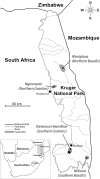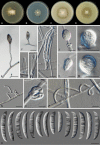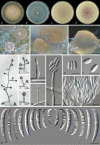New Fusarium species from the Kruger National Park, South Africa
- PMID: 29892206
- PMCID: PMC5993860
- DOI: 10.3897/mycokeys.34.25974
New Fusarium species from the Kruger National Park, South Africa
Abstract
Three new Fusarium species, F. convolutans, F. fredkrugeri, and F. transvaalense (Ascomycota, Hypocreales, Nectriaceae) are described from soils collected in a catena landscape on a research supersite in the Kruger National Park, South Africa. The new taxa, isolated from the rhizosphere of three African herbaceous plants, Kyphocarpa angustifolia, Melhania acuminata, and Sida cordifolia, are described and illustrated by means of morphological and multilocus molecular analyses based on sequences from five DNA loci (CAL, EF-1 α, RPB1, RPB2 and TUB). According to phylogenetic inference based on Maximum-likelihood and Bayesian approaches, the newly discovered species are distributed in the Fusarium buharicum, F. fujikuroi, and F. sambucinum species complexes.
Keywords: Natural parks; diversity; fungi; morphology; multigene; phylogeny.
Figures







References
-
- Aoki T, Smith JA, Mount LL, Geiser DM, O’Donnell K. (2013) Fusarium torreyae sp. nov., a pathogen causing canker disease of Florida torreya (Torreya taxifolia), a critically endangered conifer restricted to northern Florida and southwestern Georgia. Mycologia 105: 312–319. https://doi.org/10.3852/12-262 - DOI - PubMed
-
- Aydogdu H, Asan A. (2008) Airborne fungi in child day care centers in Edirne City, Turkey. Environmental Monitoring and Assessment 147: 423–444. https://doi.org/10.1007/s10661-007-0130-4 - DOI - PubMed
-
- Bent E, Kiekel P, Brenton R, Taylor DL. (2011) Root-associated ectomycorrhizal fungi shared by various boreal forest seedlings naturally regenerating after a fire in interior Alaska and correlation of different fungi with host growth responses. Applied and Environmental Microbiology 77: 3351–3359. https://doi.org/10.1128/AEM.02575-10 - DOI - PMC - PubMed
-
- Brown DJ, Clayton MK, McSweeney K. (2004) Potential terrain controls on soil color, texture contrast and grain-size deposition for the original catena landscape in Uganda. Geoderma 122: 51–72. http://doi.org/10.1016/j.geoderma.2003.12.004 - DOI
-
- Burgess LW. (2014) 2011 McAlpine Memorial Lecture – A love affair with Fusarium. Australasian Plant Pathology 43: 359–368. https://doi.org/10.1007/s13313-013-0261-8 - DOI
LinkOut - more resources
Full Text Sources
Other Literature Sources
